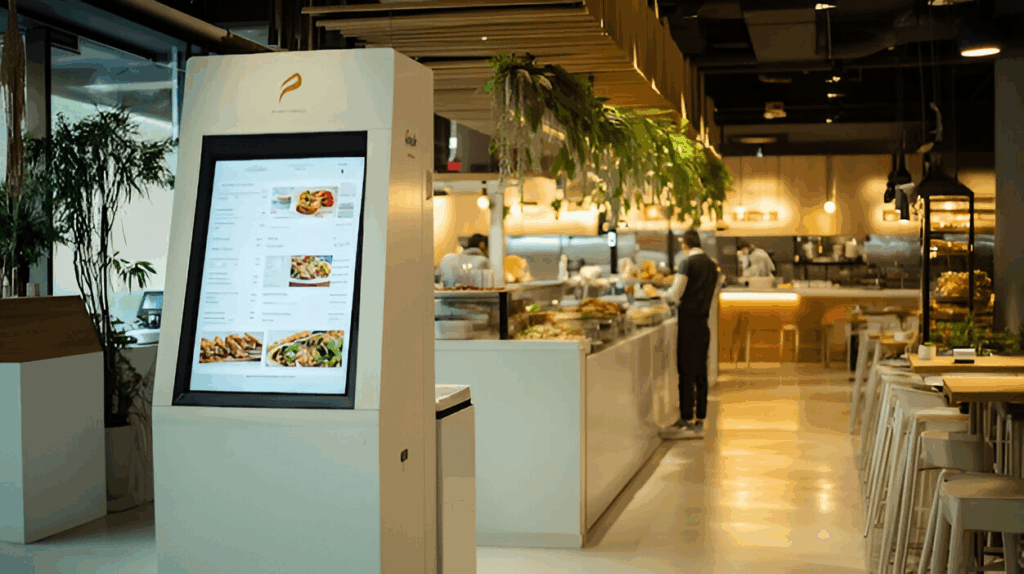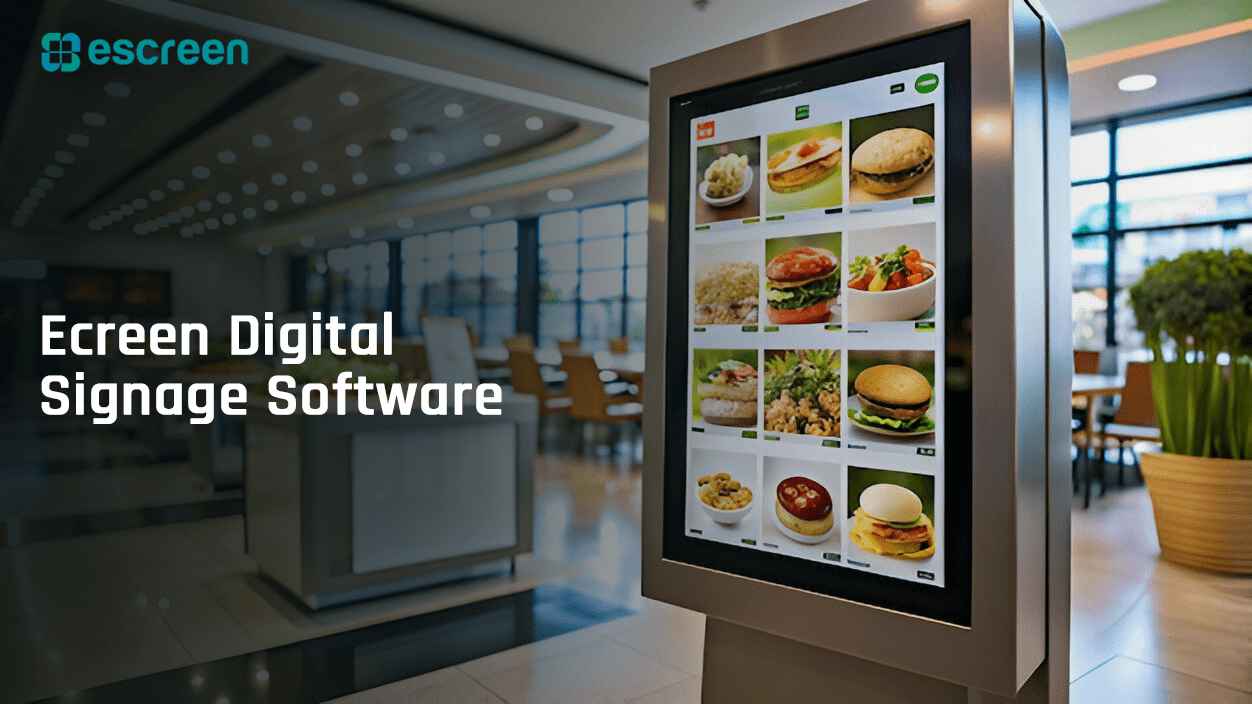Restaurants and quick-service restaurants (QSRs) across the country are abandoning traditional paper menus in favor of dynamic digital menu boards. This shift represents more than just following a technology trend it’s a strategic response to evolving consumer expectations and operational challenges in the modern food service industry.
Digital menu boards enable restaurants to display vibrant images, videos, and up-to-date information in real-time, creating an engaging visual experience that static menus simply cannot match. As competition in the restaurant space intensifies, establishments are discovering that digital menu displays offer compelling advantages that directly impact customer satisfaction and revenue.
From operational efficiency to sustainability benefits, the case for digital menu boards has never been stronger. This comprehensive guide explores why so many food service businesses are making the switch and how this technology is reshaping the dining experience.
The Changing Dynamics of Food Service
The restaurant industry is undergoing rapid transformation, driven by shifting consumer expectations and technological innovation. Today’s diners demand more than just quality food they expect memorable experiences, convenience, and modern touchpoints throughout their journey.
Meeting Modern Customer Expectations
Today’s consumers have become accustomed to digital experiences in nearly every aspect of their lives. The expectations they bring to dining establishments have evolved accordingly, with traditional paper menus often feeling outdated compared to the interactive digital experiences they encounter elsewhere.
Modern diners appreciate –
- Visual representations of menu items
- Easy-to-read, dynamic displays
- Real-time information about availability
- Interactive elements that enhance decision-making
- Technology that reflects a forward-thinking establishment
Restaurants that embrace digital menu technology signal to customers that they’re invested in creating contemporary, relevant dining experiences that align with modern lifestyle preferences.
Adapting to Industry Challenges
The restaurant industry faces persistent challenges that digital menu boards directly address –
- Labor shortages requiring more efficient operations
- Rising costs necessitating flexible pricing strategies
- Increased competition demanding stronger visual merchandising
- Supply chain disruptions requiring quick menu adjustments
- Evolving dietary preferences needing clear information display
Digital menu technology provides solutions to these pain points by enabling rapid adjustments without the logistics and expense of reprinting physical menus. This adaptability has become particularly valuable as restaurants navigate operational uncertainties and changing market conditions.
Key Benefits of Digital Menu Boards
Digital menu boards offer numerous advantages that make them increasingly attractive to restaurant owners and operators. These benefits extend beyond simple visual appeal to impact various aspects of the business.
Unmatched Flexibility in Menu Management
The ability to instantly update menu content represents one of the most compelling advantages of digital displays. Unlike printed menus that require replacement when items, prices, or promotions change, digital boards can be modified with a few clicks from a central management system.
This flexibility enables –
- Immediate removal of sold-out items
- Seamless addition of new menu offerings
- Quick implementation of price adjustments
- Instant promotion of daily specials
- Easy seasonal menu transitions
For multi-location restaurants, centralized control ensures brand consistency while allowing for location-specific customization when needed. A manager can update dozens or hundreds of displays across multiple venues simultaneously, eliminating the logistical challenges of distributing updated printed materials.
Enhanced Visual Merchandising
Digital menu boards transform static offerings into dynamic, appetizing visual experiences. High-definition displays can showcase professional food photography, videos of preparation methods, and animated content that captures attention and stimulates appetite.
Visual Elements of Digital Menu Boards and Their Impact
| Visual Element | Impact on Customer Behavior | Advantage Over Static Menus |
| Professional Food Photography | Increases sales of featured items by 30% | Creates appetite appeal through realistic presentation |
| Video Content | Extends customer attention span by 2-3x | Demonstrates preparation and quality in ways images cannot |
| Animated Promotions | Boosts promoted item sales by up to 25% | Draws attention to high-margin or seasonal offerings |
| Dayparting Transitions | Increases relevance of displayed items | Automatically adjusts to show breakfast, lunch, or dinner menus |
| Dynamic Pricing Display | Enables strategic price presentation | Allows for happy hour specials or time-based promotions |
This enhanced visual merchandising capability allows restaurants to highlight high-margin items, showcase signature dishes, and create mouth-watering displays that influence purchasing decisions before customers even speak with staff.
Impact on the Customer Experience
Digital menu boards significantly enhance how customers interact with restaurants, creating more streamlined, engaging experiences that meet modern expectations.

Accelerating the Decision-Making Process
Digital displays help customers make choices more efficiently by presenting information in clear, visually organized formats. This acceleration of the decision-making process benefits both patrons and restaurant operations –
- Reduction in perceived wait times
- Decreased line abandonment during peak periods
- Lower stress for indecisive customers
- Increased throughput during rush periods
- Improved staff efficiency with fewer explanation requirements
Quick-service restaurants particularly benefit from this streamlined process, as even small improvements in average transaction time can significantly increase service capacity during peak hours.
Creating Memorable Visual Engagement
Digital menu displays capture attention through motion, color, and visual storytelling that static menus cannot match. This engagement creates several advantages –
- Higher recall of featured items and promotions
- Increased impulse purchases of visually appealing items
- Greater awareness of new menu additions
- Enhanced perception of food quality and value
- More memorable branded experiences
This visual engagement extends the impact of marketing efforts directly to the point of purchase, when customers are most receptive to influence. The ability to showcase the actual appearance of dishes reduces uncertainty and increases confidence in ordering decisions.
Operational Efficiency Improvements
Beyond customer-facing benefits, digital menu technology delivers significant operational advantages that improve restaurant functioning and reduce workload for management and staff.
Centralizing Menu Management
Digital menu systems provide centralized control over content across multiple displays and locations –
- Single-point updates for all connected screens
- Scheduled content changes that execute automatically
- Template-based designs for consistent branding
- Permission controls for appropriate access levels
- Change logs for tracking menu modifications
This centralization reduces the administrative burden of menu management while ensuring accuracy and consistency. Restaurant groups with multiple concepts or locations gain particular efficiency by managing diverse menus through a unified system.
Minimizing Errors and Inconsistencies
Digital displays reduce several common sources of error in traditional menu systems –
- Elimination of outdated printed menus in circulation
- Consistent pricing across all customer touchpoints
- Immediate reflection of inventory availability
- Standardized presentation of nutritional information
- Automated compliance with labeling requirements
This error reduction improves customer satisfaction while reducing potential sources of confusion and complaints. Staff members benefit from having confidence that displayed information matches current offerings and pricing.
Financial Benefits for Restaurant Operators
Digital menu technology delivers measurable financial advantages that contribute to return on investment and long-term operational savings.
Reducing Long-term Operational Costs
While digital menu systems require initial investment, they typically reduce expenses over time compared to traditional menu methods –
Financial Comparison Between Traditional and Digital Menu Systems
| Expense Category | Traditional Menus | Digital Menu Boards | Estimated 3-Year Saving |
| Printing Costs | Recurring expense for replacements | One-time hardware investment | $3,000-$8,000 per location |
| Menu Update Labor | Staff time for menu replacement | Centralized digital updates | 100-200 labor hours |
| Promotional Materials | Separate signage production | Integrated into digital display | $2,000-$5,000 per location |
| Food Waste | Limited ability to remove unavailable items | Real-time inventory updates | 5-10% reduction in waste |
| Pricing Optimization | Fixed until reprinting | Dynamic pricing capability | 2-5% revenue improvement |
These savings accumulate over time, particularly for restaurants that frequently update menus or run rotating promotions. The ability to quickly adapt to supply chain fluctuations and ingredient cost changes also provides financial protection in volatile market conditions.
Driving Revenue Through Strategic Merchandising
Digital displays unlock revenue-generating capabilities that traditional menus cannot match –
- Dynamic promotion of high-margin items
- Time-based pricing strategies (happy hour, slower periods)
- Upselling through appetizing visuals of add-ons
- Cross-selling through suggested pairings and combinations
- Immediate promotion of inventory that needs rotation
Many restaurants report sales increases of 3-5% after implementing digital menu boards, with certain featured items seeing even larger sales jumps. The ability to test different presentations, offers, and positioning also enables data-driven optimization of menu performance.
Environmental Impact and Sustainability
Digital menu technology contributes to sustainability goals by reducing resource consumption associated with traditional menu production and distribution.

Reducing Paper Consumption and Waste
The environmental impact of printed menus extends beyond paper use to include –
- Ink and toner consumption
- Transportation for menu delivery
- Disposal of outdated menus
- Chemical processes in paper and ink production
- Energy used in printing operations
By eliminating these factors, restaurants reduce their environmental footprint while demonstrating commitment to sustainable practices. For establishments that update menus seasonally or more frequently, these savings can be substantial over time.
Supporting Corporate Sustainability Initiatives
Many restaurant brands have established sustainability commitments that digital menu technology supports –
- Reduced carbon footprint from menu production
- Decreased overall waste generation
- Lower resource consumption
- Alignment with eco-friendly brand positioning
- Support for paperless operation goals
These environmental benefits resonate with eco-conscious consumers who increasingly consider sustainability practices when choosing where to dine. Restaurants can highlight their digital menu implementation as part of broader sustainability communications.
QSR-Specific Implementation Trends
Quick-service restaurants face unique operational challenges and opportunities that digital menu technology specifically addresses.
Drive-Thru Innovation and Integration
Digital menu boards are transforming the drive-thru experience, which accounts for 70% or more of sales for many QSR operations –
- Weather-resistant outdoor displays with enhanced visibility
- Integration with license plate or loyalty program recognition
- Dynamic menu changes based on time of day or wait times
- Suggestive selling based on weather conditions
- Promotional content tailored to drive-thru audiences
These innovations help QSRs maximize the efficiency and profitability of this critical service channel. The ability to adjust outdoor menu content based on kitchen capacity or inventory can help manage flow during peak periods.
Data-Driven Personalization Opportunities
QSRs are increasingly leveraging digital menu technology to deliver personalized experiences –
- Customized menu recommendations based on order history
- Integration with mobile apps and loyalty programs
- Dynamic content based on local preferences and trends
- A/B testing different promotions and presentations
- Menu optimization based on performance analytics
This data-driven approach allows QSRs to refine their menu presentation continuously, creating increasingly effective customer experiences that drive sales and satisfaction simultaneously.
Future Technology Trends in Digital Menu Boards
The digital menu landscape continues to evolve, with several emerging technologies poised to further transform restaurant operations and customer experiences.
Interactive and Touchscreen Capabilities
As touch interfaces become more accepted in public spaces, restaurants are exploring interactive menu experiences –
- Customer-controlled exploration of menu items
- Customization visualization for made-to-order items
- Nutritional and allergen filtering capabilities
- Multiple language options via touch selection
- Accessibility features for diverse needs
These interactive capabilities transform menus from one-way communication tools into conversational interfaces that enhance customer control and satisfaction while reducing staff intervention requirements.
Artificial Intelligence and Predictive Displays
AI-enhanced menu systems represent the next frontier in personalized dining experiences –
- Dynamic menu adjustments based on inventory and sales velocity
- Suggestive selling informed by ordering patterns
- Weather-based menu recommendations
- Facial recognition for returning customer preferences
- Traffic pattern anticipation for kitchen preparation
While some of these technologies raise privacy considerations, their potential to improve operational efficiency and customer satisfaction ensures continued development and adoption in appropriate contexts.
Implementation Considerations for Restaurant Owners
Restaurant operators considering digital menu technology should evaluate several factors to ensure successful implementation.
Assessing System Requirements
Before selecting a digital menu solution, restaurants should consider –
- Number and placement of required displays
- Content management needs and capabilities
- Integration requirements with POS and inventory systems
- Network infrastructure and connectivity
- Hardware durability and warranty options
A thorough assessment helps identify the most appropriate solution for specific operational needs while avoiding unnecessary complications or expenses during implementation.
Measuring Return on Investment
Calculating ROI for digital menu technology should include both direct savings and indirect benefits
- Elimination of printing and distribution costs
- Labor savings from centralized management
- Revenue increases from improved merchandising
- Waste reduction through real-time availability updates
- Enhanced customer perception and experience value
Most restaurants find that properly implemented digital menu systems reach ROI breakeven within 12-24 months, with continued benefit acceleration thereafter as printing and labor costs increase over time.
Conclusion – The Future of Restaurant Menus
The shift toward digital menu boards represents a fundamental transformation in how restaurants communicate with customers at the critical decision point.

As technology continues to evolve and customer expectations rise, digital menu solutions will become increasingly sophisticated and integral to successful restaurant operations.
Forward-thinking restaurant operators recognize that digital menu boards deliver value beyond simple content display they provide a dynamic platform for merchandising, operational efficiency, and brand expression that static menus cannot match. The question for most establishments is no longer whether to implement digital menu technology, but how to maximize its benefits for their specific concept and customer base.
As we look toward the future of the restaurant industry, digital menu boards will continue to evolve from novel technology to standard infrastructure, reshaping customer experiences and operational practices along the way. Restaurants that embrace this transformation position themselves to meet changing consumer expectations while gaining valuable tools for adaptation in an increasingly dynamic market environment.
Want to learn more about implementing digital menu boards in your restaurant? Contact our team of experts for a personalized consultation that addresses your specific needs and goals.
To get help setting up easy-to-use, affordable Escreen digital signage software, start a 14-day free trial of Escreen Software here.
If you would like, you can request a demo to discover how Escreen digital signage can work for you!

